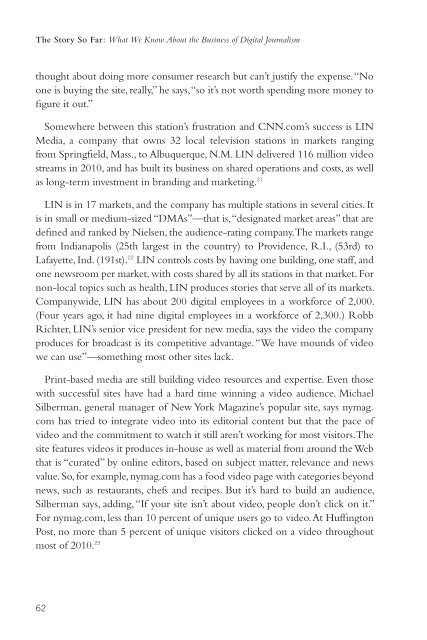What We Know About the Business of Digital Journalism
What We Know About the Business of Digital Journalism
What We Know About the Business of Digital Journalism
You also want an ePaper? Increase the reach of your titles
YUMPU automatically turns print PDFs into web optimized ePapers that Google loves.
The Story So Far: <strong>What</strong> <strong>We</strong> <strong>Know</strong> <strong>About</strong> <strong>the</strong> <strong>Business</strong> <strong>of</strong> <strong>Digital</strong> <strong>Journalism</strong>thought about doing more consumer research but can’t justify <strong>the</strong> expense. “Noone is buying <strong>the</strong> site, really,” he says, “so it’s not worth spending more money t<strong>of</strong>igure it out.”Somewhere between this station’s frustration and CNN.com’s success is LINMedia, a company that owns 32 local television stations in markets rangingfrom Springfield, Mass., to Albuquerque, N.M. LIN delivered 116 million videostreams in 2010, and has built its business on shared operations and costs, as wellas long-term investment in branding and marketing. 21LIN is in 17 markets, and <strong>the</strong> company has multiple stations in several cities. Itis in small or medium-sized “DMAs”—that is, “designated market areas” that aredefined and ranked by Nielsen, <strong>the</strong> audience-rating company. The markets rangefrom Indianapolis (25th largest in <strong>the</strong> country) to Providence, R.I., (53rd) toLafayette, Ind. (191st). 22 LIN controls costs by having one building, one staff, andone newsroom per market, with costs shared by all its stations in that market. Fornon-local topics such as health, LIN produces stories that serve all <strong>of</strong> its markets.Companywide, LIN has about 200 digital employees in a workforce <strong>of</strong> 2,000.(Four years ago, it had nine digital employees in a workforce <strong>of</strong> 2,300.) RobbRichter, LIN’s senior vice president for new media, says <strong>the</strong> video <strong>the</strong> companyproduces for broadcast is its competitive advantage. “<strong>We</strong> have mounds <strong>of</strong> videowe can use”—something most o<strong>the</strong>r sites lack.Print-based media are still building video resources and expertise. Even thosewith successful sites have had a hard time winning a video audience. MichaelSilberman, general manager <strong>of</strong> New York Magazine’s popular site, says nymag.com has tried to integrate video into its editorial content but that <strong>the</strong> pace <strong>of</strong>video and <strong>the</strong> commitment to watch it still aren’t working for most visitors. Thesite features videos it produces in-house as well as material from around <strong>the</strong> <strong>We</strong>bthat is “curated” by online editors, based on subject matter, relevance and newsvalue. So, for example, nymag.com has a food video page with categories beyondnews, such as restaurants, chefs and recipes. But it’s hard to build an audience,Silberman says, adding, “If your site isn’t about video, people don’t click on it.”For nymag.com, less than 10 percent <strong>of</strong> unique users go to video. At HuffingtonPost, no more than 5 percent <strong>of</strong> unique visitors clicked on a video throughoutmost <strong>of</strong> 2010. 2362
















